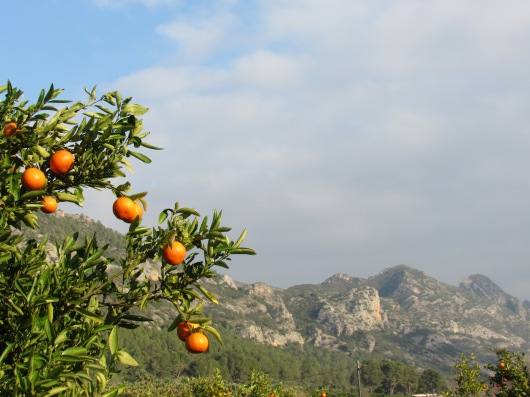
Archivo de la categoría: Bosque de Alimentos
Permaculture Favorites: E. ebbingei
[El español está abajo.]
I hadn’t intended for 6 months to go by without posting another permaculture cameo but farming is such hard work! In the meantime, however, it’s become clear which of the dozen or so permaculture helpers we planted rather late in the spring (the last week of April) have managed to adapt during quite a hot and dry summer. In addition to the goji berry mentioned here, the Elaeagnus ebbingei seems to be thriving.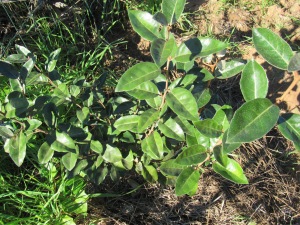
It’s water-wise and bird-friendly (due to its edible berries), thrives in poor soil and forms an effective wind-break hedge. We’ve started it on a south south-west slope that is vulnerable to wild boar attack, hoping it will eventually form a thick hedge.
Ha pasado demasiado tiempo desde que propuse una serie regular de plantas permaculturistas que comienza aquí. La que se aprecia en la foto me hace recordar otra característica favorable que no figuró en mi lista anterior, de beneficiar a las aves i/o las abejas. Los arbustos que producen pequeños frutos no venenosos por lo general lo son (las flores nutren a las abejas y los frutos a las aves). Plantamos este arbusto, Elaeagnus ebbingei, bastante tarde, después de las lluvias torrenciales de abril. Unas 2 semanas después, como es típico de la región, ya comenzó a entrar el calor. Pero el pequeño E. ebbigne se ha adaptado bien a nuestra zona de futuro secano con su suelo pobre. Con suerte en un par de años se convertirá en un seto bonito que alimente a los animalitos y a nosotros también.
Refuge / Refugi
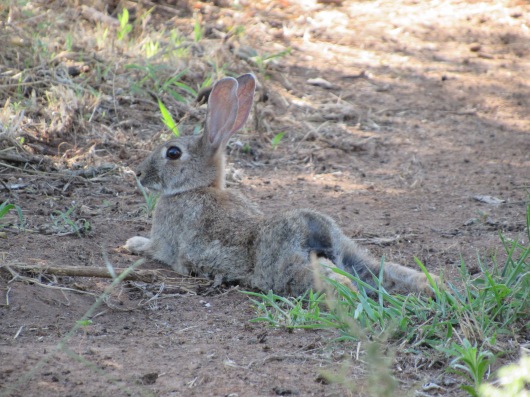
We are only aware of this big guy on our land, and he doesn’t seem to have caused any obvious damage to our garden, fortunately. Here’s a photo of our exotic tomatoes.
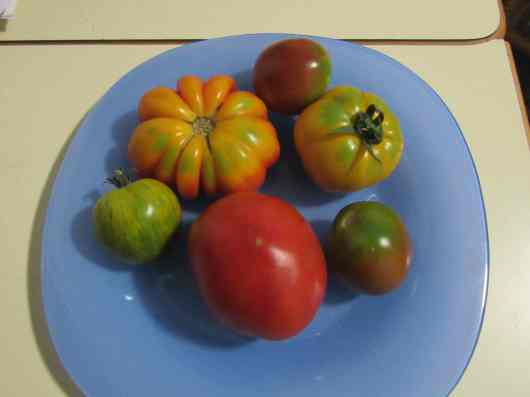
They Work Hard for Their Water
[English below.]Ahora que nuestro concepto se orienta siempre más hacia un bosque de alimentos, incorporando aspectos de la agroecología y la permacultura, comenzamos a poner más énfasis en las plantas perennes. Dicho eso, hemos definido algunos criterios para cada planta baja consideración. Fundamentalmente, están prohibidas las plantas invasoras y si alguna posee esta tendencia, las condiciones climáticas han de imposibilitar su avance. Además, buscamos un mínimo de 2, pero mejor 3 o 4 de las siguientes características para los arbustos y arboles que se incorporan. Se expresan aproximadamente por prioridad:
1) tolera la sequía / apta para la zona
2) fija o moviliza nutrientes
3) es comestible
4) atrae la fauna benéfica
5) ayuda a ‘construir suelo’
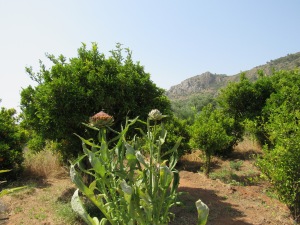
La planta de esta primera foto es uno de los pocos perennes que se cultivan en la región (Cynara scolymus) y me agrada mucho. Después de dos años y medio, están a más de 2 metros. Cada planta produce una buena docena de capullos y se propaga por esquejes, de manera bárbara. Funcionan muy bien cultivadas en los caballones entre los cítricos, con la misma programación de riego.
La segunda foto más abajo es del goji (Lycium barbarum), actualmente muy de moda, ya que la fruta es apreciada por sus propiedades creídas salubres. Aunque solemos enfatizar plantas autóctonas, hacemos unas excepciones, como este arbusto chino, que es muy valorado dentro de la comunidad permaculturista. No es invasor y al parece, se adapta bien a nuestro clima.
Now that our concept is fairly clearly orienting toward a food forest approach (albeit with certain aspects of agroecology and permaculture), our emphasis on perennial plants is increasing. In this vein, we have developed a hierarchy of requirements, the first and foremost being that the plant must not be invasive or, if so, must be held in check by our climactic conditions. I’ve spent quite enough time struggling with blackberry vines, wiregrass (Lantana camera), and prickly pears to risk introducing more invasives. Beyond that, our approach is to apply a minimum of 2, although preferably 3, of the following 5 requirements to the perennial trees and shrubs that are to become part of the long-term design. These are roughly in order of priority:
1) drought tolerance
2) nutrient-fixing or -mobilizing ability
3) edibility
4) attractive to beneficial fauna
5) soil-building capacity
Somewhat off to the side of the hierarchy is the question of whether the species is autochthonous. We want to adequately represent local species as they are of course the most adapted to the local environment and in some cases, such as the local holm oak (Quercus ilex ssp. ballota), are endangered.  But we are also introducing climate-appropriate, non-invasive exotics (such as the goji berry and moringa, so beloved of permaculturalists) to supplement traditional local varieties.Here’s a little goji bush we’ve planted with lots of mulch to preserve water these hot summer days.
But we are also introducing climate-appropriate, non-invasive exotics (such as the goji berry and moringa, so beloved of permaculturalists) to supplement traditional local varieties.Here’s a little goji bush we’ve planted with lots of mulch to preserve water these hot summer days.
There’ve been a few exceptions to the above due to the sheer pleasure of eating commercial-quality fruit (see my previous post below). The more delicate of these, from the Prunus genus (plums, peaches, nectarines and the like) at best can said to meet the edibility criteria, in addition to being non-invasive and autochthonous to the Mediterranean. However apricots and almonds, also of the Prunus genus, once established, need minimal irrigation. Indeed, due to our fairly high humidity, we´ve sadly already seen a potentially devastating disease develop in an almond (shothole disease). Not only that but several of our olives are suffering from Cycloconium oleaginym Cas, as are wild olives in the area, after the extreme amount of spring rainfall. This, then, tells us that the Prunus trees, when part of a mature food forest managed with proper spacing to provide maximal root zone shade, plus mulching to maintain moisture and deliver organic matter, may need sparse watering to produce fruit and possibly even none at all for the trees to maintain themselves. The same should hold for the olives.
Now, a little quiz: Do you recognize the amazing perennial plant pictured in the first photo? It’s a member of the thistle family that grows like, well, a weed… After two and a half years, the plants are over 2 meters (6 feet) tall and some have produced over a dozen buds (the part of the plant that is edible) each this spring. We have them heavily mulched with mowed weeds and, as they are doing just fine on the citrus irrigation schedule, we have them interspersed in between trees on the citrus rows.
The answer is… artichokes, and the photos shows buds that we have allowed to flower. We’ll try germinating them from seeds in six months or so.
Fruits of Our Labors / Fruto del Nuestro Labor
[Abajo el castellano]
This is the first year we’ve had any of our new fruit trees produce, and several haven’t yet flowered. We weren’t even expecting any production, which can typically take years in a new site. But an apricot planted in early 2017 and a nectarine planted little over a year ago in the spring actually produced 11 and 20 edible fruits, respectively. Somehow it takes me back to my childhood when I taste fruit picked straight off the tree, instead of green in preparation for hundreds of miles of refrigerated transport. I have a clear memory of a huge box of Georgia peaches my mother ordered that was the most delicious fruit of my entire childhood, though I have no memory of how we came by that fruit, as we lived a good 1000 miles away.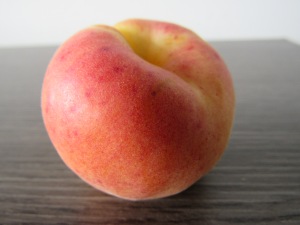
In the meantime, Juan Antón Mora, of the Bosque de Alimentos (Food Forest) de Alzira, has given us two tiny seedlings: a peach and sapote, both of which sprouted spontaneously on his land. Conventional wisdom on sapotes is, quoting the CRFG, that ¨seedlings generally produce inferior fruit, but there is always a chance of producing a worthwhile new cultivar.¨ As for the Prunus genus which includes nearly all stone fruits including almonds (in which case what one eats is the pit), all trees for commercial production are grafts. But we’ll plant these in the shade of mandarins that are still producing, for the time being, then see what happens.
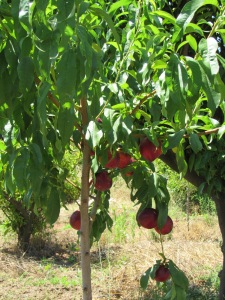
Este año nos dío una agradable sorpresa: 3 de los nuevos frutales — el almendro y el albaricoquero plantados en invierno del 2017 y un nectarino plantado hace poco más de un año — dieron fruto. ¡Qué delicia es comer fruta directamente del árbol! Me lleva de vuelta a la fruta de mi infancia, cuando todavía no se cogía fruta verde para transportarla miles de kilómetros y venderla todavía dura y sin sabor. En cambio, nuestra fruta está entre firme y tierna, jugosa, dulce y (si me permito decir) sabrosísima. Me da tanta alegría como el primer tomate que produjimos hace 3 veranos.
La foto es del nectarinero que, como casi todos los frutales, está plantado a la sombra parcial de un mandarino que ya no produce bien. Vamos abriendo espacio, cortando poco a poco las ramas de los mandarinos que luego quitaremos del todo. Evitaremos la quema de la madera, por habernos inscrito en el Programa Piloto de Trituració de Restos Agrícolas en La Casella. Esta madera triturada ya nos servirá bien para alcochonar los frutales y aportar nutrientes, mientras crezcan los arboles.
Slow Spring
[English below.] Abajo se aprecia un par de fotos del segundo taller de bioconstrucción que ha ido aún mejor que la primera, ¡claro está que la experiencia ayuda!
Y más abajo se ve lo que la tierra actualmente nos da, ya que en nuestro pequeño microclima, hemos pasado un invierno no propicio para el cultivo de hortalizas, con heladas fuertes durante casi una semana al inicio de diciembre y un par de noches otra vez bajo cero durante Fallas. Añoramos todavía la pérdida de nuestros primero intentos tropicales, los 5 aguacateros, el limero. Y nos sorprende la muerte de 2 de los 3 algarrobos que plantamos y uno que nos había salido él solo. Pero puede ser una lección valiosoa, para indicarnos que en realidad lo que tenemos en vez de un clima subtropical, característico de la costa valenciana, es más bien uno continental, por la montaña prójima y el frescor y sombra que guarda.It’s been a harsh winter, nearly a week in early December and two more nights again in March of below-freezing temperatures. The latter was after Fallas which is supposedly safely past the last freeze (tradition says to plant cucurbits on March 19th, the day of Sant Josep, the saint in whose honor the church appropriated what was probably an earlier pagan festival). At any rate, the freezes did away with all the new tropical plants we had put in (5 avocados, a lime and a pitanga), plus, surprisingly, 3 out of 4 carobs which are supposed to be hardy. And of course, as I lamented previously, the citrus.
The rest of our citrus harvest has been taken to the juice factory, about a metric ton and a half. We hired transport for about 1000 kilos and I moved the rest by bicycle cart: exactly nine trips of 50 or so kilos each, a total of 475 kilos. In total, there must have been about 2 metric tons, with the usual 10% or more ending up on the ground, to which is added what we consumed ourselves, gave away and sold (nearly 200 kilos prior to the freeze). So we know that instead of 85 or so productive trees, we have about 55 that average enough to be worth the effort, this year over 30 kilos each, but still nothing to write home about.
This has convinced us we are definitively NOT in the subtropical hardiness zone (USDA 10a) and that we need to try our luck planting for the colder continental zone (9b). We’re keeping our eye on the cherry to see if it will produce, which would be unusual for our area. Are on our way to the nursery to look at adding more warm-climate versions of apples, pears and nectarines.
On top of the cold winter, spring has been slow to come, with most of April unseasonably cool as a follow-up to the cold winter, which makes working outdoors still a pleasure. The photos above are from our second stone wall workshop.
This time in addition to working the rounded stones typical to the region, we began to work with the split stones that I scored when the barn up the hill was torn down. They are much bigger and, with more flat surfaces, I think will make the work go faster.Finally, an update on what we are eating — it was a good year for wild asparagus, and we have learned that cutting back the plants to ground level is critical to producing tasty new shoots, so we will try to find the time for that next year in amongst harvesting citrus. Our spinach struggled all winter with the cold, but the peas did well, the radishes are liking the April weather and the celery has come back for a 2nd year.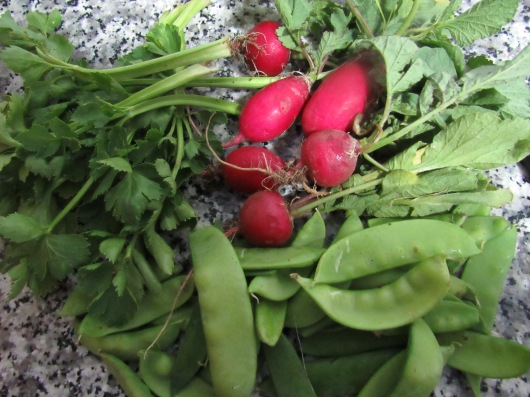
What´s for Dinner? / Actualment Mengem…
[English below.] Com som del nord, ens fa falta experiència amb verdures d´hivern. Ara hem produït solament per al auto-consumo. Hui he fet un salteado amb bròcoli, carlotes, col i nabicol, ens va be després del fred i vent que fa fora. Prompte tindrem pésols però l´espinac va lent.
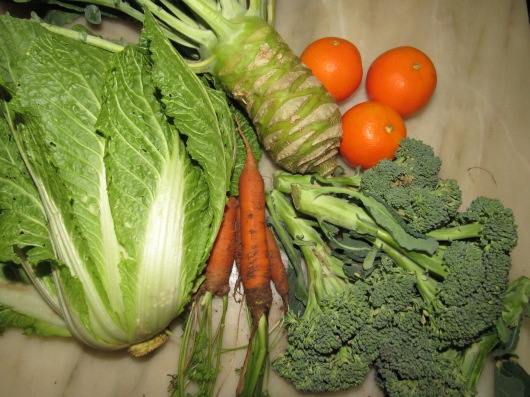
Given that we hail from northern climes, other than a couple of years of urban gardening in Madrid, we lack experience with winter crops, and last year produced little more than spindly spinach much later than I wanted, in March, which looks like it will be the case again this year. This year we´ve done better by adding brassica, peas and carrots to the mix. The broccolis are producing reasonably well and peas will be coming soon. Though the carrots are small, that will certainly improve as our soil improves (by the month). Weirdly, lettuce from two varieties we planted in the summer garden has self-seeded and is doing better than a couple of four-seasons varieties we planted in October. It gives just a slight taste of the food forest to come in the future, in this subtropical region where most seeds seem to overwinter just fine.
Actividades en Diciembre
Adjunto el cartel de la nueva idea que tenemos, de que la gente vaya a apreciar la naturaleza de este lugar tan precioso y si le parece, recoge mandarinas propias. Y más abajo, anunciamos el primer taller de la sostenibilidad que hacemos en Senda Silvestre (cartell en valencià).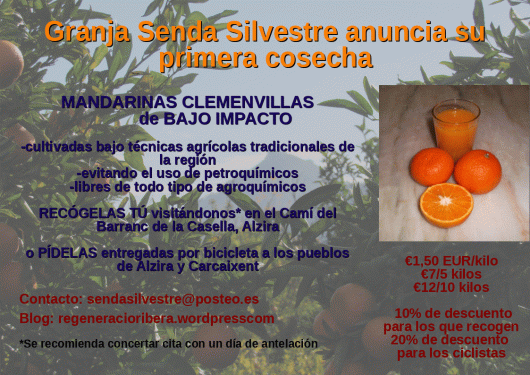
Ens fa molta il·lusió començar amb una sèrie de tallers del tema de la sostenibilitat, en aquest cas, de bioconstrucció tradicional. Benvingudes i benvinguts!
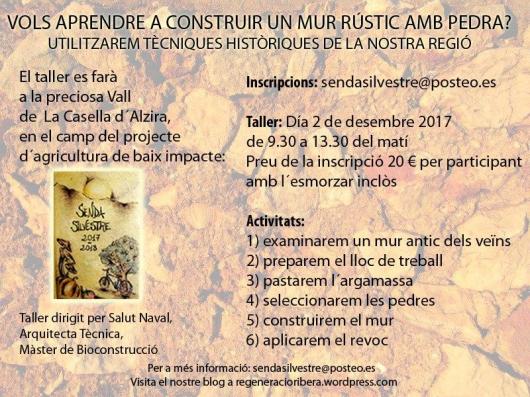
Portes Obertes el 23 de septembre
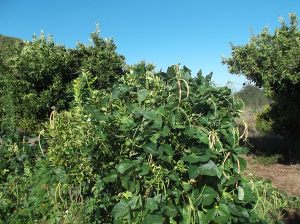
Veniu a vore els nostres arbres de fesols! Experimenteu el projecte ja després d´un any i mig de treball de horta, fruiteres i sòl. Tastarem meló d’aigua. Vos esperem des de les 17.30 fins la posta del sol.
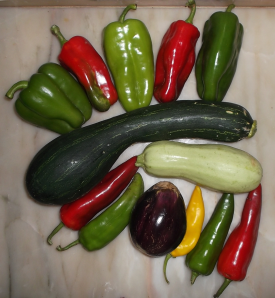 Així una seleció de verdures de setembre. Com sempre, donem als ciclistes un descompte de 20%. La pròxima vegada que se farà portes obertes és el 28 d´octubre, com sempre l´ùltim dissabte del mes.
Així una seleció de verdures de setembre. Com sempre, donem als ciclistes un descompte de 20%. La pròxima vegada que se farà portes obertes és el 28 d´octubre, com sempre l´ùltim dissabte del mes.
Portes Obertes amb Verdures Senda Silvestre
Vos convidem a anar a conéixer Granja Senda Silvestre i gaudir de la naturalesa de La Casella. Farem una volta per als que s´interessen per el nostre projecte de permacultura el pròxim dissabte 22 de juliol a les 20.30 i després tastarem tomaques, mores i melons. Ací unes fotos per a mostrar com siga l´horta.
Ja hem començat a vendre verdures, a vore si podem per ho menys cobrir el cost de l´aigua de reg! Per als ciclistes que aneu a la parcel.la, oferim un descompte de 20%, per a fomentar el transport sostenible dels nostres productes. També les portem per supost al centre d´Alzira i de vegades al centre de Carcaixent, com és el cas este diumenge 16 a les 18.30.



